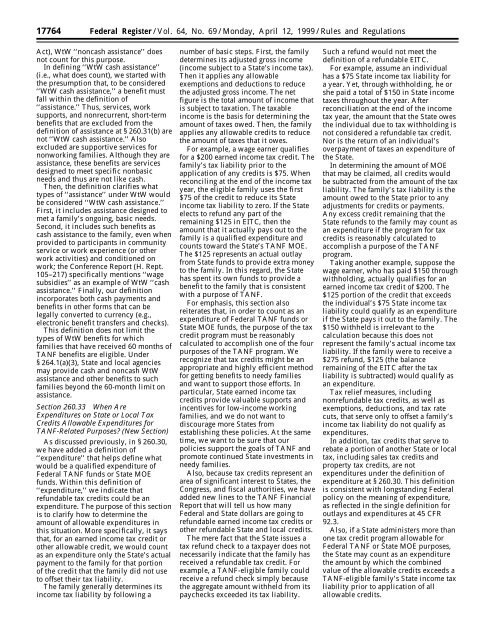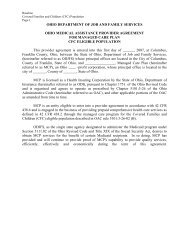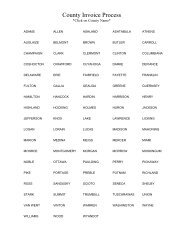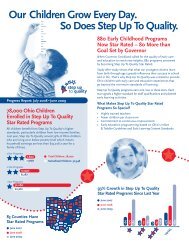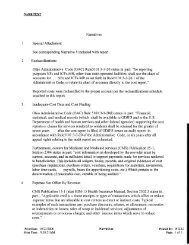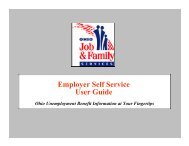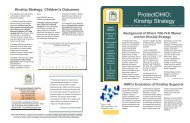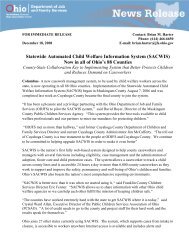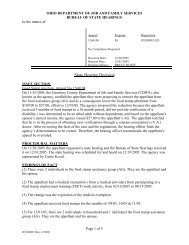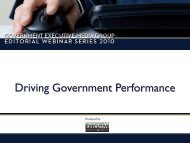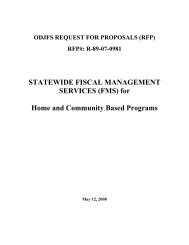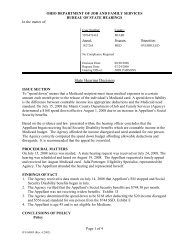Final TANF Rule as published in the Federal Register 4/12/1999
Final TANF Rule as published in the Federal Register 4/12/1999
Final TANF Rule as published in the Federal Register 4/12/1999
You also want an ePaper? Increase the reach of your titles
YUMPU automatically turns print PDFs into web optimized ePapers that Google loves.
17764 <strong>Federal</strong> <strong>Register</strong> / Vol. 64, No. 69 / Monday, April <strong>12</strong>, <strong>1999</strong> / <strong>Rule</strong>s and Regulations<br />
Act), WtW ‘‘nonc<strong>as</strong>h <strong>as</strong>sistance’’ does<br />
not count for this purpose.<br />
In def<strong>in</strong><strong>in</strong>g ‘‘WtW c<strong>as</strong>h <strong>as</strong>sistance’’<br />
(i.e., what does count), we started with<br />
<strong>the</strong> presumption that, to be considered<br />
‘‘WtW c<strong>as</strong>h <strong>as</strong>sistance,’’ a benefit must<br />
fall with<strong>in</strong> <strong>the</strong> def<strong>in</strong>ition of<br />
‘‘<strong>as</strong>sistance.’’ Thus, services, work<br />
supports, and nonrecurrent, short-term<br />
benefits that are excluded from <strong>the</strong><br />
def<strong>in</strong>ition of <strong>as</strong>sistance at § 260.31(b) are<br />
not ‘‘WtW c<strong>as</strong>h <strong>as</strong>sistance.’’ Also<br />
excluded are supportive services for<br />
nonwork<strong>in</strong>g families. Although <strong>the</strong>y are<br />
<strong>as</strong>sistance, <strong>the</strong>se benefits are services<br />
designed to meet specific nonb<strong>as</strong>ic<br />
needs and thus are not like c<strong>as</strong>h.<br />
Then, <strong>the</strong> def<strong>in</strong>ition clarifies what<br />
types of ‘‘<strong>as</strong>sistance’’ under WtW would<br />
be considered ‘‘WtW c<strong>as</strong>h <strong>as</strong>sistance.’’<br />
First, it <strong>in</strong>cludes <strong>as</strong>sistance designed to<br />
met a family’s ongo<strong>in</strong>g, b<strong>as</strong>ic needs.<br />
Second, it <strong>in</strong>cludes such benefits <strong>as</strong><br />
c<strong>as</strong>h <strong>as</strong>sistance to <strong>the</strong> family, even when<br />
provided to participants <strong>in</strong> community<br />
service or work experience (or o<strong>the</strong>r<br />
work activities) and conditioned on<br />
work; <strong>the</strong> Conference Report (H. Rept.<br />
105–217) specifically mentions ‘‘wage<br />
subsidies’’ <strong>as</strong> an example of WtW ‘‘c<strong>as</strong>h<br />
<strong>as</strong>sistance.’’ <strong>F<strong>in</strong>al</strong>ly, our def<strong>in</strong>ition<br />
<strong>in</strong>corporates both c<strong>as</strong>h payments and<br />
benefits <strong>in</strong> o<strong>the</strong>r forms that can be<br />
legally converted to currency (e.g.,<br />
electronic benefit transfers and checks).<br />
This def<strong>in</strong>ition does not limit <strong>the</strong><br />
types of WtW benefits for which<br />
families that have received 60 months of<br />
<strong>TANF</strong> benefits are eligible. Under<br />
§ 264.1(a)(3), State and local agencies<br />
may provide c<strong>as</strong>h and nonc<strong>as</strong>h WtW<br />
<strong>as</strong>sistance and o<strong>the</strong>r benefits to such<br />
families beyond <strong>the</strong> 60-month limit on<br />
<strong>as</strong>sistance.<br />
Section 260.33 When Are<br />
Expenditures on State or Local Tax<br />
Credits Allowable Expenditures for<br />
<strong>TANF</strong>-Related Purposes? (New Section)<br />
As discussed previously, <strong>in</strong> § 260.30,<br />
we have added a def<strong>in</strong>ition of<br />
‘‘expenditure’’ that helps def<strong>in</strong>e what<br />
would be a qualified expenditure of<br />
<strong>Federal</strong> <strong>TANF</strong> funds or State MOE<br />
funds. With<strong>in</strong> this def<strong>in</strong>ition of<br />
‘‘expenditure,’’ we <strong>in</strong>dicate that<br />
refundable tax credits could be an<br />
expenditure. The purpose of this section<br />
is to clarify how to determ<strong>in</strong>e <strong>the</strong><br />
amount of allowable expenditures <strong>in</strong><br />
this situation. More specifically, it says<br />
that, for an earned <strong>in</strong>come tax credit or<br />
o<strong>the</strong>r allowable credit, we would count<br />
<strong>as</strong> an expenditure only <strong>the</strong> State’s actual<br />
payment to <strong>the</strong> family for that portion<br />
of <strong>the</strong> credit that <strong>the</strong> family did not use<br />
to offset <strong>the</strong>ir tax liability.<br />
The family generally determ<strong>in</strong>es its<br />
<strong>in</strong>come tax liability by follow<strong>in</strong>g a<br />
number of b<strong>as</strong>ic steps. First, <strong>the</strong> family<br />
determ<strong>in</strong>es its adjusted gross <strong>in</strong>come<br />
(<strong>in</strong>come subject to a State’s <strong>in</strong>come tax).<br />
Then it applies any allowable<br />
exemptions and deductions to reduce<br />
<strong>the</strong> adjusted gross <strong>in</strong>come. The net<br />
figure is <strong>the</strong> total amount of <strong>in</strong>come that<br />
is subject to taxation. The taxable<br />
<strong>in</strong>come is <strong>the</strong> b<strong>as</strong>is for determ<strong>in</strong><strong>in</strong>g <strong>the</strong><br />
amount of taxes owed. Then, <strong>the</strong> family<br />
applies any allowable credits to reduce<br />
<strong>the</strong> amount of taxes that it owes.<br />
For example, a wage earner qualifies<br />
for a $200 earned <strong>in</strong>come tax credit. The<br />
family’s tax liability prior to <strong>the</strong><br />
application of any credits is $75. When<br />
reconcil<strong>in</strong>g at <strong>the</strong> end of <strong>the</strong> <strong>in</strong>come tax<br />
year, <strong>the</strong> eligible family uses <strong>the</strong> first<br />
$75 of <strong>the</strong> credit to reduce its State<br />
<strong>in</strong>come tax liability to zero. If <strong>the</strong> State<br />
elects to refund any part of <strong>the</strong><br />
rema<strong>in</strong><strong>in</strong>g $<strong>12</strong>5 <strong>in</strong> EITC, <strong>the</strong>n <strong>the</strong><br />
amount that it actually pays out to <strong>the</strong><br />
family is a qualified expenditure and<br />
counts toward <strong>the</strong> State’s <strong>TANF</strong> MOE.<br />
The $<strong>12</strong>5 represents an actual outlay<br />
from State funds to provide extra money<br />
to <strong>the</strong> family. In this regard, <strong>the</strong> State<br />
h<strong>as</strong> spent its own funds to provide a<br />
benefit to <strong>the</strong> family that is consistent<br />
with a purpose of <strong>TANF</strong>.<br />
For emph<strong>as</strong>is, this section also<br />
reiterates that, <strong>in</strong> order to count <strong>as</strong> an<br />
expenditure of <strong>Federal</strong> <strong>TANF</strong> funds or<br />
State MOE funds, <strong>the</strong> purpose of <strong>the</strong> tax<br />
credit program must be re<strong>as</strong>onably<br />
calculated to accomplish one of <strong>the</strong> four<br />
purposes of <strong>the</strong> <strong>TANF</strong> program. We<br />
recognize that tax credits might be an<br />
appropriate and highly efficient method<br />
for gett<strong>in</strong>g benefits to needy families<br />
and want to support those efforts. In<br />
particular, State earned <strong>in</strong>come tax<br />
credits provide valuable supports and<br />
<strong>in</strong>centives for low-<strong>in</strong>come work<strong>in</strong>g<br />
families, and we do not want to<br />
discourage more States from<br />
establish<strong>in</strong>g <strong>the</strong>se policies. At <strong>the</strong> same<br />
time, we want to be sure that our<br />
policies support <strong>the</strong> goals of <strong>TANF</strong> and<br />
promote cont<strong>in</strong>ued State <strong>in</strong>vestments <strong>in</strong><br />
needy families.<br />
Also, because tax credits represent an<br />
area of significant <strong>in</strong>terest to States, <strong>the</strong><br />
Congress, and fiscal authorities, we have<br />
added new l<strong>in</strong>es to <strong>the</strong> <strong>TANF</strong> F<strong>in</strong>ancial<br />
Report that will tell us how many<br />
<strong>Federal</strong> and State dollars are go<strong>in</strong>g to<br />
refundable earned <strong>in</strong>come tax credits or<br />
o<strong>the</strong>r refundable State and local credits.<br />
The mere fact that <strong>the</strong> State issues a<br />
tax refund check to a taxpayer does not<br />
necessarily <strong>in</strong>dicate that <strong>the</strong> family h<strong>as</strong><br />
received a refundable tax credit. For<br />
example, a <strong>TANF</strong>-eligible family could<br />
receive a refund check simply because<br />
<strong>the</strong> aggregate amount withheld from its<br />
paychecks exceeded its tax liability.<br />
Such a refund would not meet <strong>the</strong><br />
def<strong>in</strong>ition of a refundable EITC.<br />
For example, <strong>as</strong>sume an <strong>in</strong>dividual<br />
h<strong>as</strong> a $75 State <strong>in</strong>come tax liability for<br />
a year. Yet, through withhold<strong>in</strong>g, he or<br />
she paid a total of $150 <strong>in</strong> State <strong>in</strong>come<br />
taxes throughout <strong>the</strong> year. After<br />
reconciliation at <strong>the</strong> end of <strong>the</strong> <strong>in</strong>come<br />
tax year, <strong>the</strong> amount that <strong>the</strong> State owes<br />
<strong>the</strong> <strong>in</strong>dividual due to tax withhold<strong>in</strong>g is<br />
not considered a refundable tax credit.<br />
Nor is <strong>the</strong> return of an <strong>in</strong>dividual’s<br />
overpayment of taxes an expenditure of<br />
<strong>the</strong> State.<br />
In determ<strong>in</strong><strong>in</strong>g <strong>the</strong> amount of MOE<br />
that may be claimed, all credits would<br />
be subtracted from <strong>the</strong> amount of <strong>the</strong> tax<br />
liability. The family’s tax liability is <strong>the</strong><br />
amount owed to <strong>the</strong> State prior to any<br />
adjustments for credits or payments.<br />
Any excess credit rema<strong>in</strong><strong>in</strong>g that <strong>the</strong><br />
State refunds to <strong>the</strong> family may count <strong>as</strong><br />
an expenditure if <strong>the</strong> program for tax<br />
credits is re<strong>as</strong>onably calculated to<br />
accomplish a purpose of <strong>the</strong> <strong>TANF</strong><br />
program.<br />
Tak<strong>in</strong>g ano<strong>the</strong>r example, suppose <strong>the</strong><br />
wage earner, who h<strong>as</strong> paid $150 through<br />
withhold<strong>in</strong>g, actually qualifies for an<br />
earned <strong>in</strong>come tax credit of $200. The<br />
$<strong>12</strong>5 portion of <strong>the</strong> credit that exceeds<br />
<strong>the</strong> <strong>in</strong>dividual’s $75 State <strong>in</strong>come tax<br />
liability could qualify <strong>as</strong> an expenditure<br />
if <strong>the</strong> State pays it out to <strong>the</strong> family. The<br />
$150 withheld is irrelevant to <strong>the</strong><br />
calculation because this does not<br />
represent <strong>the</strong> family’s actual <strong>in</strong>come tax<br />
liability. If <strong>the</strong> family were to receive a<br />
$275 refund, $<strong>12</strong>5 (<strong>the</strong> balance<br />
rema<strong>in</strong><strong>in</strong>g of <strong>the</strong> EITC after <strong>the</strong> tax<br />
liability is subtracted) would qualify <strong>as</strong><br />
an expenditure.<br />
Tax relief me<strong>as</strong>ures, <strong>in</strong>clud<strong>in</strong>g<br />
nonrefundable tax credits, <strong>as</strong> well <strong>as</strong><br />
exemptions, deductions, and tax rate<br />
cuts, that serve only to offset a family’s<br />
<strong>in</strong>come tax liability do not qualify <strong>as</strong><br />
expenditures.<br />
In addition, tax credits that serve to<br />
rebate a portion of ano<strong>the</strong>r State or local<br />
tax, <strong>in</strong>clud<strong>in</strong>g sales tax credits and<br />
property tax credits, are not<br />
expenditures under <strong>the</strong> def<strong>in</strong>ition of<br />
expenditure at § 260.30. This def<strong>in</strong>ition<br />
is consistent with longstand<strong>in</strong>g <strong>Federal</strong><br />
policy on <strong>the</strong> mean<strong>in</strong>g of expenditure,<br />
<strong>as</strong> reflected <strong>in</strong> <strong>the</strong> s<strong>in</strong>gle def<strong>in</strong>ition for<br />
outlays and expenditures at 45 CFR<br />
92.3.<br />
Also, if a State adm<strong>in</strong>isters more than<br />
one tax credit program allowable for<br />
<strong>Federal</strong> <strong>TANF</strong> or State MOE purposes,<br />
<strong>the</strong> State may count <strong>as</strong> an expenditure<br />
<strong>the</strong> amount by which <strong>the</strong> comb<strong>in</strong>ed<br />
value of <strong>the</strong> allowable credits exceeds a<br />
<strong>TANF</strong>-eligible family’s State <strong>in</strong>come tax<br />
liability prior to application of all<br />
allowable credits.


